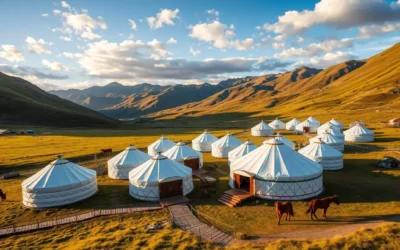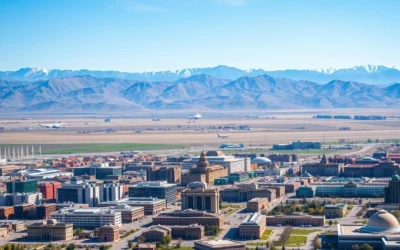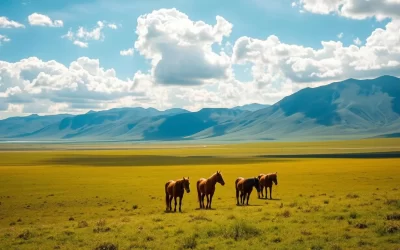✓ Accommodations✓ Flights✓ Rental Cars✓ Tours & Activities
Language plays a pivotal role in defining cultural identity. In this country, it serves as a bridge connecting history, tradition, and modern practices. The primary language spoken here is Mongolian, used by nearly 5-6 million people.
This nation’s linguistic landscape is unique, featuring both Cyrillic and traditional scripts. These writing systems reflect a blend of historical influences and contemporary needs. Understanding this dual-script system offers insight into the country’s rich heritage.
With a population of approximately 3.6 million speakers, language policies here are crucial for preserving cultural identity. These policies ensure that the official language remains a cornerstone of national unity. Dive deeper to explore how language shapes this country’s identity and its people.
Historical Evolution of the Mongolian Language
From ancient roots to modern dialects, the Mongolian language has evolved significantly. Its journey reflects centuries of cultural and historical change, shaped by nomadic traditions and global influences.
Early Nomadic Influences and Ancient Roots
The origins of the Mongolian language trace back to the Proto-Mongolic period. Early nomadic cultures played a key role in its development. By the 13th century, texts like the Secret History of the Mongols documented its use.
During the Middle Mongol period (13th–16th centuries), the language began to standardize. This era saw the translation of Buddhist texts, further enriching its vocabulary. The oldest known text in the traditional script dates back to 1225.
Transition from Middle Mongol to Modern Dialects
By the 17th century, the language entered its New Mongolian phase. This period marked the emergence of modern dialects like Khalkha, now the national standard. The introduction of the Cyrillic script in the 1940s further shaped its modern form.
| Period | Key Developments |
|---|---|
| Old Mongolian (up to 12th century) | Proto-Mongolic roots, nomadic influences |
| Middle Mongolian (13th–16th centuries) | Standardization, Buddhist translations |
| New Mongolian (17th century–present) | Modern dialects, Cyrillic script adoption |
Today, the Mongolian language continues to evolve. Its rich history and adaptability make it a vital part of cultural identity. Understanding its journey offers insight into the resilience of linguistic traditions.
Mongolia: Official and widely spoken languages
Government policies play a crucial role in preserving linguistic heritage. In this country, the primary language is supported through deliberate regulations. These policies ensure its use in public education, media, and official documents.
Language councils oversee its implementation, shaping how it’s taught and communicated. For example, regulations maintain the use of both traditional and Cyrillic scripts. This dual-script system reflects a balance between historical roots and modern needs.
Specific policy measures promote national identity. Schools emphasize the primary language in curriculums, fostering pride and unity. Media outlets also adhere to these standards, ensuring widespread exposure.
The Role in National Identity
Language is more than a means of communication—it’s a symbol of cultural identity. In this country, it serves as a unifying force, connecting people across regions. Government efforts to standardize its use strengthen this bond.
Heritage policies play a key role in preserving traditional scripts. These measures ensure that historical texts remain accessible, bridging past and present. By maintaining these practices, the country safeguards its unique identity.
Through policy and education, the primary language continues to thrive. It’s not just a tool for daily life but a cornerstone of national pride. Understanding its role offers insight into the country’s cultural resilience.
Exploring the Dialects and Varieties in Mongolia
The linguistic diversity of this region is a testament to its rich cultural heritage. Dialects here reflect centuries of cultural and geographic influences, creating a vibrant linguistic landscape. From the dominant Khalkha to the lesser-known Chakhar, each dialect tells a unique story.

Khalkha, Chakhar, and Other Variants
Khalkha is the most widely spoken dialect, serving as the national standard. It’s used in education, media, and government. Chakhar, on the other hand, is prominent in the eastern regions, known for its distinct phonetic features.
Other variants include Ordos and Khorchin, each with unique characteristics. These dialects form a cohesive group, showcasing the region’s linguistic richness. Understanding their differences helps appreciate the cultural depth they represent.
Oirat and Buryat: Unique Regional Features
Oirat and Buryat are notable for their regional influences. Oirat is spoken in the western areas, while Buryat is prevalent in the north and parts of Inner Mongolia. These dialects highlight the connection between language and geography.
Social and cultural factors have shaped these dialects over time. For example, Buryat incorporates elements from neighboring languages, reflecting its historical interactions. This blend of influences makes it a fascinating subject of study.
| Dialect | Region | Unique Features |
|---|---|---|
| Khalkha | Central | National standard, used in media |
| Chakhar | Eastern | Distinct phonetic patterns |
| Oirat | Western | Influenced by neighboring languages |
| Buryat | Northern | Blend of regional and historical elements |
These dialects are more than just linguistic variations—they’re a reflection of the region’s history and identity. Exploring them offers a deeper understanding of the cultural tapestry that defines this area.
The Role of Script: Traditional Mongolian vs. Cyrillic
Scripts are more than symbols; they carry the weight of history. In this region, the traditional Mongolian script and the Cyrillic alphabet coexist, reflecting a blend of cultural pride and modern adaptation. Understanding their roles offers insight into the nation’s identity.
Transition to the Cyrillic Alphabet
The Cyrillic script became dominant in 1946, replacing earlier Latin-based systems. This shift was influenced by Soviet policies, aiming to standardize literacy and education. By 1950, literacy rates soared from 17.3% to 73.5%, showcasing its impact.
Despite its prevalence, the Cyrillic alphabet includes unique letters like Өө and Үү, tailored to the language’s phonetic needs. This adaptation highlights the balance between external influence and local requirements.
Maintaining the Traditional Mongolian Script
The traditional Mongolian script, in use since 1204, remains a symbol of cultural heritage. Its vertical writing style and unique letter forms distinguish it from other scripts. Today, it’s used ceremonially and in Inner Mongolia, preserving its historical significance.
Government initiatives aim to revive its usage. By 2025, plans include integrating it into official documents alongside Cyrillic. However, challenges like incomplete technological support and limited literacy in the script persist.
Efforts to teach the traditional script in schools reflect its cultural value. Students begin learning it in Grade 6, dedicating two hours weekly to its study. These steps ensure its legacy endures, bridging past and present.
Language Policy and Regulation in Mongolia
Over the years, language policies have shaped the educational and cultural landscape of this region. These regulations have evolved to reflect the needs of a changing society, ensuring the preservation of linguistic heritage while adapting to modern demands.
In the academic year 2019-2020, out of 263,397 pupils, 194,664 were learning English as a second language, while approximately 2,300 studied it as a first language. This highlights the growing importance of English in education. Proficiency testing for freshmen students studying ‘English I’ (A2 level) revealed that over 90% failed the assessment.
The teacher/student ratio in secondary schools increased from 15.1 in 2001 to 21.8 in 2019, a 44.4% rise. Similarly, universities saw a 36.4% increase in this ratio during the same time period. These changes reflect the challenges in maintaining quality education amidst growing student numbers.
Government initiatives have prioritized English since 1990, allocating significant funds for its dissemination in schools. However, proficiency tests on 40 students learning English II (pre-intermediate) showed a 77.5% failure rate. This indicates a gap between policy goals and actual outcomes.
| Year | Policy Change | Impact |
|---|---|---|
| 1990 | Prioritization of English | Increased funding for English education |
| 2001 | Teacher/student ratio adjustments | Improved resource allocation |
| 2019 | Proficiency testing expansion | Highlighted gaps in language education |
These policy adjustments reflect cultural and educational priorities. For example, the government’s focus on English aims to prepare students for global opportunities. Yet, challenges remain in achieving desired proficiency levels.
Understanding these policies helps you appreciate the balance between tradition and modernization. Language regulation is not just about rules—it’s about shaping the future of education and identity.
Cultural Significance of the Mongolian Language
The Mongolian language is more than words—it’s a bridge to the past. It carries the stories, values, and traditions of generations. For many, it’s a way to connect with their roots and preserve their identity.

Every name in this language holds meaning. It reflects not just personal identity but also family heritage. Names often honor ancestors, linking the present to the past.
Families play a key role in keeping the language alive. Through oral traditions, stories are passed down from one generation to the next. These tales are more than entertainment—they’re lessons in history and culture.
Language as a Vessel of Tradition and Identity
The influence of family is evident in how the language is preserved. Parents teach their children the importance of speaking it fluently. This ensures that cultural values remain intact.
Written texts also play a part. Historical documents and literature are treasured for their insights into the past. They serve as a reminder of the language’s enduring legacy.
- Oral traditions keep history alive.
- Names connect individuals to their heritage.
- Families are the guardians of language.
Through these practices, the Mongolian language continues to shape cultural narratives. It’s not just a means of communication but a symbol of unity and pride.
Influence of Soviet Alignment on Mongolian Language and Script
The alignment with Soviet policies reshaped the linguistic and cultural identity of this region. This period marked a significant shift in how people communicated and preserved their heritage. The introduction of the Cyrillic alphabet in the 1940s under Soviet influence was a turning point.
Adoption of the Cyrillic Script and Russian Borrowings
On January 1, 1946, the Cyrillic alphabet became the official writing system. This change aimed to standardize literacy and align with Soviet educational models. Over the next 21 years, literacy rates soared from 2% to over 97%, showcasing its success.
The Cyrillic script included 36 letters, with two unique to this system: Ө and Ү. These adaptations ensured the script met the phonetic needs of the language. Despite its efficiency, the traditional script, known for its low legibility, was gradually sidelined.
Russian borrowings also became prevalent during this era. Words from politics, technology, and daily life entered the vocabulary, reflecting broader global trends. This blend of influences highlights the interplay between local traditions and foreign language impacts.
Historical figures like Genghis Khan symbolize the region’s rich past, while Soviet reforms represent a modern shift. The juxtaposition of these eras continues to shape contemporary linguistic practices.
By 2025, the government plans to reintroduce the traditional script in official documents alongside Cyrillic. This move aims to balance historical pride with modern efficiency. However, challenges like limited technological support and literacy in the traditional script remain.
Understanding this transition offers insight into how foreign influences can reshape a nation’s identity. The legacy of Soviet alignment remains a key part of the linguistic landscape, connecting the past to the present.
Geographic Distribution and Regional Variations
The geographic spread of languages reveals fascinating regional patterns. Across this vast area, dialects and practices vary significantly. These differences are shaped by location, terrain, and historical influences.
In the north, the language reflects close ties to neighboring cultures. This region’s dialects often include unique phonetic features. For example, the Buryat dialect incorporates elements from nearby languages.
Central areas, on the other hand, are dominated by the Khalkha dialect. It serves as the national standard and is widely used in media and education. This uniformity contrasts with the diversity found in other regions.
Terrain plays a key role in shaping language trends. Mountainous areas often preserve older dialects, while plains see more linguistic blending. These variations highlight the connection between geography and culture.
| Region | Dialect | Unique Features |
|---|---|---|
| North | Buryat | Influenced by neighboring languages |
| Central | Khalkha | National standard, used in media |
| West | Oirat | Distinct phonetic patterns |
Understanding these regional differences helps you appreciate the cultural richness of this area. Language is not just a tool for communication—it’s a reflection of identity and history.
Foreign Language Influence and Adoption in Mongolia
Globalization has reshaped how foreign languages are embraced in this region. Over time, external influences have enriched the local lexicon, blending tradition with modernity. This section explores how foreign languages have been integrated into society, education, and daily life.

Russian, German, and Other Foreign Languages
Russian has had a profound impact, especially during the Soviet era. The Cyrillic script, introduced in 1946, remains widely used today. Many words from Russian, particularly in politics and technology, have become part of everyday vocabulary.
German, though less prevalent, has also left its mark. Historical ties and educational exchanges have introduced German words into the local language. These borrowings reflect the region’s openness to global influences.
The Rise of English and Korean
In recent years, English has surged in popularity. It’s now a key part of school curriculums, with many students learning it as a second language. This trend aligns with the government’s push to prepare youth for global opportunities.
Korean, driven by cultural exports like K-pop and dramas, has also gained traction. Young people are increasingly learning Korean, making it one of the fastest-growing foreign languages spoken here.
Foreign language adoption is not just about communication—it’s a reflection of cultural exchange. As spoken mongolia evolves, it continues to embrace global influences while preserving its unique identity.
“Language is the road map of a culture. It tells you where its people come from and where they are going.”
To learn more about how foreign languages are shaping education, check out this study on internationalization in higher education.
Turkic and Minority Languages Spoken in Mongolia
The linguistic tapestry of this region is enriched by the presence of Turkic language and minority groups. These languages add depth to the cultural mosaic, reflecting the diversity of the nation.
Among the minority groups, Kazakhs stand out, making up 3.9% of the population. Their language, a branch of the Turkic language family, is widely spoken in Bayan-Ölgii province, where they form around 75% of the local population.
Other groups, like the Durvud and Bayad, also contribute to this linguistic diversity. Each person from these communities helps preserve their native tongue, ensuring it remains a vital part of the nation’s heritage.
Despite challenges, these languages thrive in educational and public settings. For example, Kazakh schools now offer textbooks in their native language, a shift from earlier policies. This change highlights the importance of linguistic preservation.
Linguistic diversity is a strength for the nation. It fosters cultural plurality and connects people across ethnic backgrounds. By embracing these languages, the region celebrates its rich heritage and ensures its future.
Phonology and Grammar: Understanding Mongolian Structure
The structure of the Mongolian language is a fascinating blend of phonology and grammar. Its unique features make it stand out among other languages. One of the most distinctive aspects is its vowel harmony, which plays a central role in shaping words and sentences.
Vowel Harmony and Syllabic Complexity
Vowel harmony is a key feature of the mongolic language. It ensures that vowels within a word harmonize in terms of their form and pronunciation. For example, Mongolian Halh has seven vowel phonemes: /i/, /e/, /a/, /u/, /ʊ/, /o/, and /ɔ/.
This harmony extends to diphthongs, which include combinations like /ui/, /ʊi/, /ɔi/, and /ai/. Understanding this system helps you grasp how words are constructed and pronounced in Mongolian.
Syllabic complexity is another defining trait. Words are formed using agglutinative rules, where affixes are added without fusion. This creates long, multi-syllabic words that carry detailed meanings.
- Vowel harmony ensures consistency in pronunciation.
- Syllabic structure allows for detailed word formation.
- Agglutinative rules make the language highly expressive.
These features make Mongolian a distinct and rich language. Its phonology and grammar reflect a deep connection to its cultural roots. By exploring these aspects, you gain a deeper appreciation for its complexity and beauty.
Language Use in Education and Media
Education and media serve as powerful tools in shaping linguistic identity. In this region, schools play a crucial role in preserving and promoting the primary language. Through formal education, students learn to value their linguistic heritage while gaining essential skills for the modern world.
Incorporating Mongolian in School Curriculums
Schools across the region have integrated the primary language into their curriculums. This ensures that students develop fluency and cultural pride. For example, language-specific subjects are taught from early grades, fostering a deep connection to heritage.
Government policies support this integration by setting standards for language instruction. Teachers are trained to deliver high-quality lessons, ensuring students achieve competency. This approach has led to measurable improvements in language proficiency.
Media also plays a vital role in promoting the primary language. Television programs, radio shows, and online content are produced in the local tongue. This widespread exposure helps reinforce language skills outside the classroom.
| Initiative | Impact |
|---|---|
| Curriculum Integration | Boosts fluency and cultural pride |
| Teacher Training | Ensures high-quality instruction |
| Media Representation | Reinforces language skills |
Despite these efforts, challenges remain. The recent bilingual education policy in Inner Mongolia has sparked debates. Critics argue it undermines the role of the primary language in education.
Understanding these dynamics helps you appreciate the balance between tradition and modernization. Language in education and media is not just about communication—it’s about preserving identity and fostering unity.
Economic Factors Shaping Language Trends
Economic forces have a profound impact on how languages evolve and are used in daily life. Trade, government funding, and globalization are key parts of this process. These factors shape language preferences and usage in both urban and rural areas.
In urban centers, economic development often leads to the adoption of foreign language elements. For example, English has become a vital part of business and education, driven by global trade. This trend is a result of the need to compete internationally.
Rural areas, on the other hand, tend to preserve traditional languages. However, economic pressures can still influence language use. For instance, government funding for education often determines which languages are taught in schools.
Market forces also play a significant role. As industries grow, they create demand for specific language skills. This can lead to shifts in language trends over time. For example, the rise of tourism has increased the use of foreign languages in certain regions.
Balancing cultural preservation with economic modernization is a challenge. While foreign languages open up opportunities, they can also overshadow local dialects. Policies that support both parts of this equation are essential for sustainable development.
To learn more about how economic transformations influence language trends, check out this detailed report.
Modern Challenges and Preservation Efforts
In the face of modernization, preserving linguistic heritage has become a pressing challenge. The population today faces a delicate balance between embracing progress and safeguarding cultural identity. This section explores the struggles and the inspiring efforts to keep the language alive.
Addressing Declines and Revivals in Language Use
One of the biggest challenges is the decline in traditional language use among younger generations. Urbanization and globalization have shifted preferences toward more globally dominant languages. However, revival efforts are gaining momentum, with initiatives aimed at reconnecting the population to their roots.
Community-driven programs play a vital role in these efforts. Local organizations are creating platforms for language learning, from schools to cultural festivals. These initiatives help bridge the gap between generations, ensuring the language remains a living part of daily life.
Government policies also provide a strong link between preservation and education. By integrating the language into school curriculums, students are encouraged to value their heritage. Public awareness campaigns further amplify these efforts, making the language accessible to all.
Funding is another critical factor. Investments in language preservation projects have increased, supporting everything from digital resources to traditional arts. These efforts not only revive the language but also create economic opportunities for the population.
Despite these successes, challenges remain. Technological advancements often favor dominant languages, creating barriers for smaller linguistic communities. Addressing these issues requires innovative solutions, such as developing language-specific software and apps.
Today, the fight to preserve the language is a testament to its cultural significance. By understanding the challenges and supporting revival efforts, we can ensure its survival for future generations. The link between policy, community, and technology holds the key to its future.
The Impact of History on Contemporary Language Practices
History leaves an indelible mark on how we communicate today. From ancient empires to modern reforms, the past continues to shape the way we speak and write. Every man carries a piece of this history in their words, reflecting a shared cultural legacy.
Take, for example, the influence of the Mongol Empire. Its vast reach introduced Mongolian words into languages like Russian and Turkic. Words such as “Moscow” and “Kremlin” are believed to have Mongolian origins, showcasing the deep historical ties between cultures.

Even in modern times, these historical influences persist. A survey revealed that 40.2% of students cited personal interest as a key factor in learning foreign languages. This curiosity often stems from a desire to connect with historical narratives.
Every day, people use phrases and expressions rooted in history without even realizing it. For instance, the Khalkha dialect, dating back to the 17th century, remains a cornerstone of communication in certain regions. This dialect serves as a living reminder of the past.
Cultural legacies also play a role. The Secret History of the Mongols, written in the 13th century, preserves a version of the language that still influences modern dialects. Such texts bridge the gap between generations, ensuring that history remains alive in our speech.
To learn more about how historical ties shape language, explore this detailed study on the subject. Understanding these connections helps you appreciate the richness of language and its deep roots in history.
Conclusion
The journey through this linguistic landscape reveals a rich tapestry of cultural identity. The mongolian script and spoken dialects intertwine to form a unique heritage. From the vowel harmony of its phonology to the agglutinative grammar, every aspect reflects centuries of tradition.
Dedicated speakers play a vital role in keeping this language alive. Their efforts ensure that the mongolian script remains a symbol of pride and continuity. Whether in urban centers or rural areas, the language adapts while preserving its roots.
Economic trends and global influences shape its evolution, yet the core identity remains intact. To learn more about cultural nuances, explore this detailed guide. The future of this linguistic heritage lies in balancing tradition with innovation, ensuring it thrives for generations to come.
The above is subject to change.
Check back often to TRAVEL.COM for the latest travel tips and deals.





